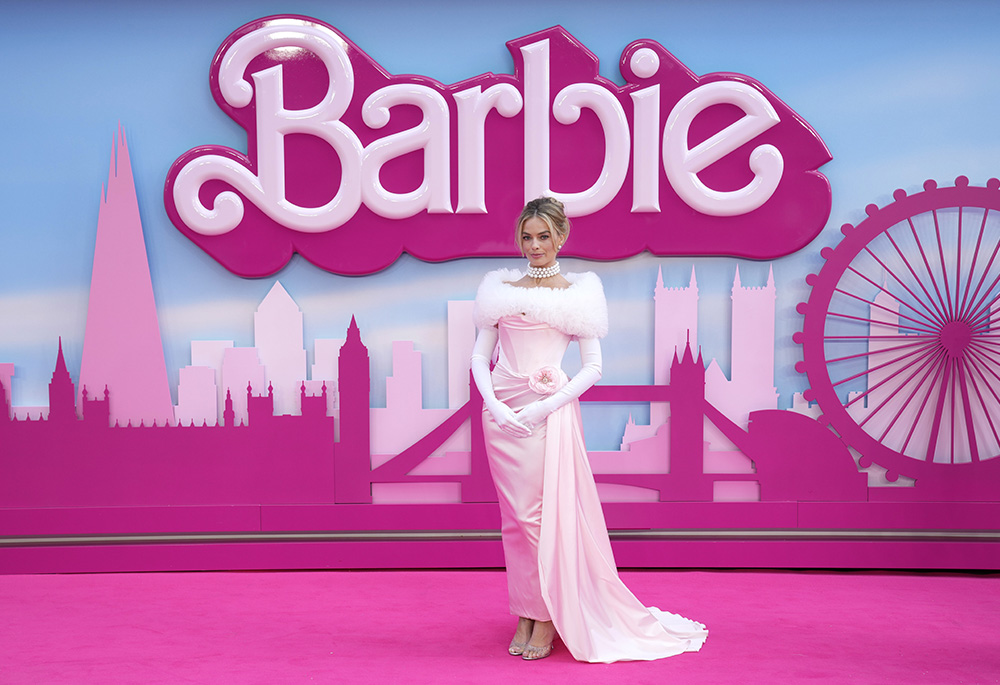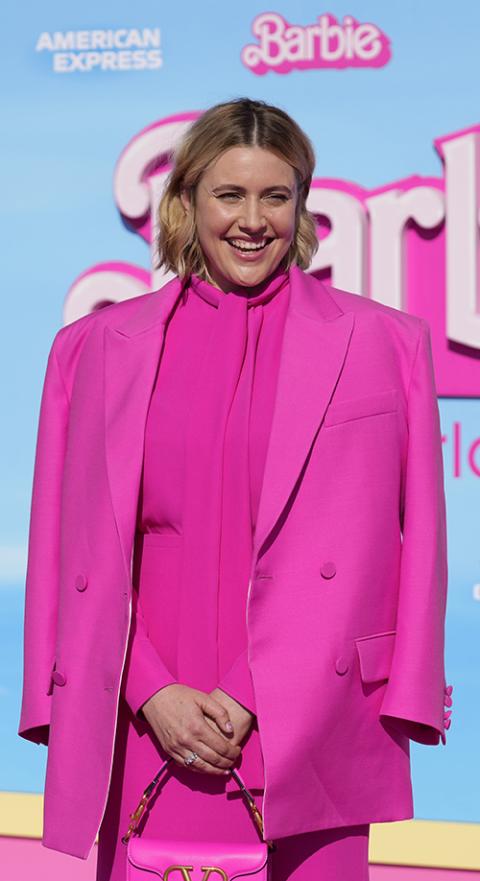
Margot Robbie poses for photographers upon arrival at the premiere of the film "Barbie" in London July 12. (AP/Invision/Scott Garfitt)
Editor's Note: This commentary contains spoilers for the film "Barbie."
In the Catholic liturgical tradition, the color pink is associated with joy. But it is not joy untinged by visceral experience of pain, regret and sorrow. In the midst of the dark season of Advent, Catholics longing for the light of Jesus' birth use pink to celebrate Gaudete Sunday. In the middle of late winter's Lenten season, pink signifies Laetare Sunday. It points toward Easter Sunday's theme of Resurrection, even as it recognizes the inevitability of Jesus's suffering and death on Good Friday.
Thinking about the color pink in this way helps bring a theological lens to the summer blockbuster movie "Barbie," about the plastic doll first produced by the Mattel toy company in 1959 and played with by millions of girls over the past 60 years.
That lens is a natural one. Greta Gerwig, who co-authored the screenplay and directed the movie, has admitted how much her Catholic education has shaped her approach to "Barbie." Gerwig's highly acclaimed film "Lady Bird" (2017) is a semi-autobiographical account of years at St. Francis, an all-girls Catholic high school in Sacramento, California.

Writer-director Greta Gerwig arrives at the premiere of "Barbie" in Los Angeles July 9. (AP/Chris Pizzello)
As many commentators have pointed out, the "Barbie" movie is in large part a feminist reframing of the doll and its messaging for modern young women. It is a joyous celebration of "girl power." But it is also an ode to perseverance, compassion and hope in the midst of suffering and injustice. Set against the inevitability of death, "Barbie" is a post-COVID creative work.
We can think of "Barbie" as yet another retelling of humanity's origin story found in the book of Genesis. Barbie Land is presented as a Garden of Eden, where all the Barbies and Kens seem to live in vivid but languid enjoyment.
Work in Barbie Land is not an activity, much less an onerous one. Instead, work is background scenery or even merely an accessory. (Ken's job is "beach"—not "lifeguard," not "model," just "beach.") There is no sex (as everyone knows, Barbies have no genital parts). There is no food (Barbies eat pretend food).
And there is no aging or death. While Barbie Land features Barbies of every size, shape and color, including some with disabilities, they are all between 15 and 35 years old. They are all in the pink of health.
But one day, Barbie Land begins to lose its rosy luster, as aspects of the real world begin to mar its perfection. Stereotypical Barbie (played by Margot Robbie) suddenly finds herself preoccupied by persistent thoughts of death. She has developed — gasp — cellulite. And her unnaturally arched foot, which makes wearing high-heeled shoes supremely comfortable, has fallen flat as a pancake.
The movie "Barbie" retells the fall from paradise — but unlike the biblical story, it is told as a woman's fall from paradise into patriarchy.
There are striking correlations between the movie and the Western theological tradition. Barbie laments the undesired and unexpected collapse of her arches just as St. Augustine lamented the undesired and unexpected collapse of his penis. He speculated that there would have been no erectile dysfunction in the Garden of Eden.
Paradise does not permit our bodies to disappoint us in any way whatsoever. After the Fall, however, the betrayal of our bodies is a regular occurrence.
The movie 'Barbie' retells the fall from paradise — but unlike the biblical story, it is told as a woman's fall from paradise into patriarchy.
In the biblical story, Eve's curiosity and greed precipitate the banishment from Eden. In the movie, it is Barbie's courage and empathy that provokes the rough transition from Barbie Land to the real world. Weird Barbie (Kate McKinnon) informs Stereotypical Barbie that the rip in Barbie Land is caused by someone who played with her angrily and fearfully in the real world. To save Barbie Land, Barbie has to find this human being and assuage her suffering.
In the process of coming to terms with the real world, she slowly decides she belongs there.
Here the movie takes a turn toward the felix culpa tradition, which places great value on human life and society after the Fall. In fact, as the Latin suggests, original sin might have been a fortunate occurrence. Adam and Eve gain something by eating from the Tree of Knowledge, even as they lose immortality.
The broken uncertainty of the postlapsarian world generates opportunities for human beings to exercise their agency in cooperation with God. Relationships with one and other become sweeter, because they are given life in the face of diminishment and death.
Christian theologians have long speculated that it is better to be an imperfect, finite human being than an angel. Western filmmakers before have made the same point before Gerwig.
For example, in Wim Wenders's 1987 film "Der Himmel über Berlin" (the English title is "Wings of Desire"), the angel Damiel decides to relinquish his wings and become a human being. After an eon of observing messy and painful human life from a state of unchanging perfection, he longs to experience choice, risk and love for himself, even at the cost of immortality. When the woman he falls in love with loses her life in a tragic accident, Damiel's decision appears foolhardy. Yet he resolves to keep living, honoring the beauty in the fragility of his days.
Advertisement
Filmed in black and white, "Der Himmel über Berlin" makes its point about the poignancy of human existence in shades of gray. The "Barbie" movie makes the same point using the color pink. After her escape wreaks havoc with their bottom line, the all-male leadership of the Mattel Toy Company offers Barbie the opportunity to resume her perfect life in Barbie Land — all she has to do is get back in the packaging box (complete with zip ties to constrain her wrists) and go home.
Barbie instinctively recoils from returning to life in a box. Yet her reasons for remaining in the real world are far from selfish; in fact, they touch upon the transcendent.
She is mesmerized by the loveliness in the face of an older woman — someone she would not come across in Barbie Land. She confronts the appalling truth that Barbie dolls have been used to make real women feel inferior and inadequate about themselves. And she commits herself to make things better, now treating work as a noble human activity rather than as a fashion accessory.
What, exactly, does it mean "to make things better"? While justice is fiercely honored, the moral virtue that animates the movie is compassion. Barbie breaks down in tears when she hears about the anger and pain of her human being, who is not a little girl, but rather a grown woman named Gloria (America Ferrera) trying to raise her bright and complicated teenage daughter Sasha (Ariana Greenblatt) seemingly without much help from her husband.*
Mother and daughter detest and resent how the doll was used to manipulate them with false standards of femininity and rigid standards of perfection. At the same time, they do not let their anger get the best of them; they do not leave Barbie in the clutches of the evil toy company, which only wants to use her to generate more money. When they hear about her insecurities, they recognize that Barbie is a victim of the patriarchy too.
We know that the point of Barbie's creation was not to diminish or demean real women. We know because Ruth Handler, her creator, said so. Ruth, played by Rhea Pearlman and modeled on the doll's actual inventor, firmly but kindly reminds Barbie (and the audience) that no one can actually be Barbie — except, of course, for Barbie herself.
Ruth's goal in creating the doll was to enable little girls to dream broadly about their lives as grownups. Playing with Barbie was supposed to unlock their creativity, not suffocate their self-worth.
Ruth wants what is best for Barbie, too — which means letting her take her own path. After warning her about the disadvantages of reality, Ruth acquiesces when Barbie decides to pursue an imperfect life of creativity in the real world rather than a perfect life as a created object in Barbie Land. No theologian could put the point more vividly.
Looking at Barbie Land from the perspective of Ken is rather like looking at Eden from the perspective of Eve. Do we really know whether Eve was happy?
Unlike God, human creators are always flawed. One problem with Barbie Land is that no one, including Ruth, seems concerned about Ken's well-being. Barbie Land isn't a patriarchy, of course. More troublingly, it isn't a sinless matriarchy, where women take responsibility for all their political children, male and female.
In fact, the very first cracks in Barbie Land were experienced by Stereotypical Ken (Ryan Gosling), not by Barbie. Ken inchoately desires something more out of his life, and out of his relationship with Barbie, than being an affable boy-toy. He wants love, respect — and sex.
His own voyage to the real world introduced him to the patriarchy, which he unsuccessfully attempted to bring back to Barbie Land. After the Barbies defeat this endeavor, in part by turning the Kens against each other, Ken becomes a broken man.
He at least had the good sense to recognize that patriarchy wasn't all it was cracked up to be, even for men. And he had the courage to admit that he was really into riding horses like a cowboy, not the patriarchy itself.
Looking at Barbie Land from the perspective of Ken is rather like looking at Eden from the perspective of Eve. Do we really know whether Eve was happy? If so, why was she so receptive to the temptations of the serpent in the first place? She was created, after all, as a helpmeet for Adam, not for her own sake.
But given Barbie's history, it might be more useful to examine Ken's plight in view of the new Eden created by 1950s postwar white American family life. This era is increasingly the object of our nostalgia. As Betty Friedan trenchantly exposed in The Feminine Mystique (1963), the homes that were made during that time were not entirely blissful for the women who were supposed to be at their heart. Many housewives felt numb and alienated in their suburban utopias, although they couldn't quite explain why.

Ryan Gosling and Margot Robbie star in a scene from the movie “Barbie.” (OSV News/Warner Bros.)
In my view, Ken's existential crisis in Barbie Land is not very different from the crisis experienced by Friedan's stereotypical 1950s white housewife. Suffocating under norms imposed upon him by rigid social roles, Ken struggles to find an identity that is not fully defined by his partner, who is a more powerful and compelling figure than he could ever be.
Ken's next task might be to give up beach for the library, so he can write The Masculine Mystique for all the men in Barbie Land.
The "Barbie" movie begins with a group of little girls playing with baby dolls in the sand. Then a larger-than-life Barbie doll descends from the air as the girls look on with wonder and admiration. They toss their baby dolls onto the ground and into the air and gather around Barbie, who smiles at them beneficently.
The movie ends with Barbie, now going by her full name of Barbara Handler, going to her first appointment with the gynecologist. She is no longer a plasticized giant, but rather an ordinary-sized flesh-and-blood human being.
What should we make of these bookends? Some might say that the first scene signals a feminist ideology opposed to motherhood. I don't see it that way; in fact, I think the movie tries to broaden our notion of motherhood beyond a fixation on babies. Teenage girls, grown women, and even living dolls like Barbie need mothering, too.
Others might worry that the last scene re-inscribes the biological tyranny women experience in a patriarchal society. My own view is more positive. I see Barbie as accepting responsibility for having a biologically complete female body that is both wonderfully strong and potentially fragile.
The bodies of women in Barbie Land are plastic; they don't age, they don't die, they don't make love and they can't make children. Embodied women in the real world do all of these things.
And, as both the doll and the "Barbie" movie remind us, they do many other things as well. But before doing any of them, women must take care of their own basic needs, including the needs of their terrifyingly wonderful female bodies.
*This sentence has been updated for clarity.








